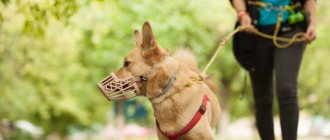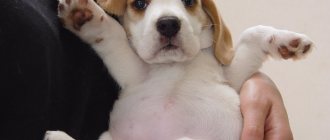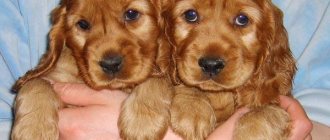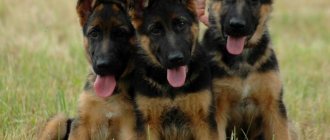When to start training
Training a puppy begins from the moment it appears in the house. As a rule, the baby is taken from the breeder at 2.5-3 months. You should not do this earlier, as in the future there may be problems with the socialization of the pet, and with its psyche.
Practicing the “nearby” command
For your information! The sooner a puppy is separated from its mother, the worse it is for it; such a pet will develop problems with behavior among its own kind and people. Many puppies separated from their mother too early are nervous and hysterical and difficult to train.
After bringing the puppy into the house, they give him a couple of days to get used to the new place and slowly begin to train him. It is more precise to establish contact between the owner and the new family member.
Basic training methods
How to train a puppy? There are two teaching methods:
- development of a classical conditioned reflex;
- learning using instrumental conditioning.
How to properly train a dog at home
When developing a classical conditioned reflex, an unconditioned response is reinforced. Schematically, this method looks like this: conditioned and unconditioned stimuli - unconditioned response - reinforcement. In other words, the dog is given a command (conditioned stimulus), then a mechanical effect is applied to the pet (for example, pressing on the croup after giving the command “sit”), the dog sits down and receives a treat. Instead of learning to think and understand what should be done to receive reinforcement, the puppy simply demonstrates an elementary unconditioned reaction caused by the previous factor, and even receives a reward for it.
When trained through instrumental conditioning, the puppy learns to think. A simple example: a pet simply loves to play with balls; he doesn’t need any treats. The owner plays with the baby, at some point the dog sits down, and its owner immediately gives a command and reinforces it with a toy.
Next time the pet wants to get the coveted ball, but the owner does not give the toy to the pet. And the baby begins to try in every possible way to get her, demonstrating various types of behavior. Ultimately, the dog will sit down again, and the owner will immediately give the necessary command and, finally, please the pet with a ball. This is where the animal begins to think, the dog forms a connection between its behavioral repertoire and reinforcement - in order to get the ball, you need to sit down.
Note! The first method is good for its speed, the second is long, but more reliable. There is no force on the animal to perform this or that action, the dog simply begins to think, instead of stupidly receiving an object of motivation (a treat or a toy).
Age features of training
If you get your first dog, it is advisable to create a training plan. If a basic training course is enough for you, focus all your resources and efforts on this.
If your puppy is very active or a working breed, a general training course will not be enough.
1 month
When the puppy is 1 month old, he begins to actively explore the world, learn to build relationships with his relatives, and is interested in adult food. During this period, he has to quickly learn a huge number of new skills.
It is up to you to teach your puppy to go to the toilet in a certain place. You should not count on a guaranteed execution of the skill, since small puppies can “play too much” without feeling the urge to urinate.
Advice: if the puppy came into your home at the age of 1 month, it is better to spend the first 3-4 weeks building trust and learning the basic rules of behavior in the house.
2–3 months
At 2–3 months, the puppy receives primary vaccination. Walking outside should be done with caution, only in remote areas where other dogs are not walked.
At home, you can train him to come on command, go to a place, and not enter the eating area while you are cooking or busy with everyday activities.
4–6 months
At the age of 4-6 months comes the most fruitful time for learning. After the puppy receives a full vaccination, you need to accustom him to regular walks and relieve himself outside.
While the puppy is at home, he can be taught basic commands. The child must learn that he will be rewarded for obeying.
Preparing to train a puppy
How to train a husky and raise a puppy at home
Before you start teaching your dog commands at home, you need to establish contact with it. The fact is that nothing good will happen without it. In the Soviet Union there was an unspoken rule - mechanical influence on the dog is mandatory, the dog must be afraid of the handler. And to this day, in old books on training, sometimes there are pearls that make you want to cry. Some dog handlers proudly write about how they broke their boots on the backs of their dogs, and the animals, approaching them on half-bent legs, urinated in fear.
This is not training, but bullying. If the owner turns to a dog handler, and he recommends similar methods, you should run from such a specialist as from fire. Violence will never help in the relationship between dog and owner. In the best case, the pet will shrink and become afraid of the owner, in the worst case, the residents of Russia will see another story in the news about a killer dog that devoured its own owner.
Ball game
And now about how to properly train a puppy and about establishing contact with him. This is done through the game. The toys used are soft flagella, balls on ropes made of soft rubber or latex.
Important! You need to play with your baby anywhere and everywhere, especially while walking. Like with a kitten, putting a toy on the ground and holding it up with a string. The curious puppy will begin to catch up with her, and the owner must remember one rule: the pet always remains the winner in this game. I caught the toy and the owner gave it to the dog.
And one more thing: the puppy must understand that being around the owner is interesting and fun. For those who want to get a dog motivated by the owner, it is recommended:
- Avoid walking in a pack of dogs. This is when the owners walk on their own, and the dogs run around without leashes, filling the area with joyful barks. What kind of motivation can we talk about on the owner at the moment, if the animals sometimes don’t even hear what the owners say to them;
- limit contact with other dogs. They met, the animals sniffed each other and went their separate ways, each with its owner. There is no need for hours of games turned into the above;
- Never hit or kick a dog. The hand is a moment of pleasure (affection, treat), and the owner’s leg is the calmest place where the puppy feels protected;
- constantly play with the dog while walking, don’t be afraid to show emotions. By and large, a pet can be motivated by its owner even without toys with treats. The animal cares about the owner’s reaction to his correct actions. A person who is proudly called an owner should not be afraid to show joyful emotions when his dog has performed the desired action. Owners should be generous with sincere, joyful praise towards their puppy. It’s sad to see how the puppy correctly followed the command, and the owner, in a voice devoid of any emotional overtones, weakly praises the baby. And the dog is at a loss, either he is stupid, or he did something wrong;
- be proud of your pet, even if it’s just a mixed breed, popularly called a mongrel. By the way, many mixed breeds are much smarter than purebred dogs with a pedigree of several pages.
Don't be afraid to show emotions
Basic commands for dogs - list
What commands to teach a dog depends on its owners. Some people like the animal to fetch objects, others want the dog to fiercely guard the house. But in both cases, she must know the basic commands that develop strength, dexterity and intelligence in animals. The list of basic commands for dogs includes the following settings:
- Sit. A simple command needed in everyday life. The dog should stop whatever it is doing and sit down. You can start training as early as one and a half months;
- Lie. This command is used much less frequently, but the dog learns it very easily. When following a command, the animal must lie on the ground and remain in that position;
- Stand. This procedure requires a lot of endurance and concentration from the puppy, so training should begin after 5 months, when conditioned reflexes to previous commands have already been developed;
- Place. At this command, the dog must go to its place. This could be her bedding or a specific place in the house;
- Aport. Retrieval means that the dog must find and bring to the owner the object thrown by him. Usually she must sit next to her and wait until the found item is taken from her. This command is very popular with active animals and provides basic search skills;
- Near. Knowledge of the command is necessary, since you will have to use it every day. The dog must be on the left side, and move in sync with the owner, regardless of whether he is on a leash or not.
- To me. One of the most important settings is that you can start training when the puppy is 1.5-2 months old. At this command, the pet must approach the owner and sit on the left side.
- Ugh. A vital command that makes an animal stop misbehavior or give up the idea of picking something up from the floor.
These are the most important commands a dog should know.
In raising an animal, all the nuances are important: voice, emotions, gestures, encouragement. The main teaching tool should be voice intonation. Commands should be spoken clearly and calmly. A reproachful tone should only appear if the puppy behaves incorrectly. Do not punish your dog with your hand or leash. The most you can do is pat him by the scruff of the neck and scold him in a stern voice. And then all actions aimed at teaching a dog commands will turn into an easy and fun process, pleasant for the owner and his pet.
Instructions for training first skills
When a puppy appears in the house, its upbringing begins immediately. Of course, you cannot constantly give an inhibitory command, unless, of course, the owner wants to get a neurotic dog in the future. But some rules of behavior (not to confuse raising a puppy with training a puppy at home) must be instilled in the animal from the very first days, regardless of the breed of the baby, be it a charming dachshund or a handsome Great Dane.
How to train a husky: raising a puppy at home
As many future owners know, you cannot walk your pet until the second vaccination. The first is often done by the breeder, the second by the owner. But the baby goes to the toilet, will the whole apartment really turn into a springboard for dog waste? Nothing of the kind, the owner just needs to teach the pet to do its business in the diaper.
Note! Disposable diapers for animals are sold in all pet stores; they are quite cheap and economical to use.
So, barely noticing how the puppy is restlessly marking time, trying to choose a secluded corner for his needs, the owner carefully picks him up, carries him to a diaper, sits him down, strokes him and says “here”, “business”, etc. After that As a husky, mistakenly called a husky by the people, a pug or a chow-chow, as well as a puppy of any other breed, has done its business, it is praised and treated to something tasty. Within normal limits, of course, the treat should be one sip.
The owner must act in this way until the puppy learns to run on its own in the diaper, having felt certain calls from the body.
Now it remains to consider the problem of the pet walking throughout the apartment. Some people allow the baby to move around the house, while others don’t want this at all. Therefore, from the first days of a puppy in the house, he is taught to move only in a certain area, for example, in the hallway and in the kitchen.
If the owner entered the room, and his corgi, Doberman or Akita Inu ran in after him, the actions are as follows:
- They take the baby in their arms.
- They are taken out of the room.
- Place it at the entrance so that the pet can see the owner.
- They say the command “wait”.
- They enter the room for a few seconds.
- They go out to the puppy, praise him and encourage him.
A pet trained in this way will wait for the owner not only in the house, but also at the door of a store, for example. Although it is not recommended to leave the animal outside without the supervision of the owner unless absolutely necessary. You can go shopping without a dog, you never know how many inappropriate people there are around. Representatives of small breeds are especially often stolen, but large dogs are also taken away from store doors.
Ideally, the pet should also have its own house where it can relax without outside interference. Today, special dog cages and boxes are popular; they can be seen in the photo below.
Boxing for dogs
The dog feels comfortable and cozy in such a “pen,” although a lot depends on the breed of the pet. It is unlikely that Yorkies, being rather shy dogs, will be happy in a confined space. But larger and more balanced representatives of a particular breed, for example, Labradors, will simply be happy to be alone with themselves.
Stages of accustoming a puppy to a bed (box, crate, kennel):
- First you need to put a treat in the box so that your pet can see it.
- Then the word “box” or “place” is pronounced and the puppy is shown the direction with his hand.
- When the dog enters the kennel (box, cage), the door closes. When he eats the treat, praise your pet and after 3-5 seconds. release into the wild.
- The time the dog stays in the box increases by 1-2 seconds every day. When the puppy learns to be calm in a confined space, you can slowly begin to leave your pet alone.
And finally, training to use a collar and leash. This should be done from the first days of the baby’s stay in the house. The owner simply puts the collar on him for a few seconds at first, gradually increasing the time. If the animal reacts calmly to a foreign object on its neck, it is praised and treated to something tasty.
Note! The main thing is to take into account the breed of the puppy. Some immediately get used to the collar, being strong and with a stable psyche (Laika, as an option), while others try to faint as soon as they feel it on their neck. The owner must act delicately, wisely, without morally violating the pet.
Walking on a leash
Methods of training and giving commands
Conventionally, training methods can be divided into:
- Motivational. By observing the pet, effective stimuli are established, with the help of which the puppy can be pushed to correctly execute the command. If the command is successfully executed, he receives the desired result - a toy, praise, spending time with the owner.
- Carrot and stick. The puppy is praised for correct behavior, and blamed for incorrect behavior. Some dog breeds are obstinate during training, so punishment and reprimand are inevitable.
- Dictatorial. This method only works if the pet has unconditional respect for the owner. The method is not suitable for inexperienced dog owners, since there is a very fine line between receiving unconditional respect and instilling fear in the dog.
Methods for issuing commands can be divided into:
- Verbal - voice.
- Non-verbal - gestures.
- Special - commands are given with a whistle or clicker.
- Mixed.
Promotion methods:
- Emotional – praise, short play.
- Material - a toy.
- Food – delicacy.
Methods of punishment:
- Emotional – demonstrative resentment, ignoring the pet.
- Verbal – raising the tone of voice, expressing dissatisfaction.
- Physical – jerk with a leash, slap, ruffle of the withers.
Note! Most professional dog trainers do not encourage any physical punishment during training.
After a series of experiments and observations, it became clear that physical punishment humiliates the importance and authority of the owner in the eyes of the pet. The dog concludes that the person cannot cope with his emotions and resorts to violence. With this method of training, some, especially service breeds, can follow the example of the owner.
What commands should a puppy know?
The most important dog commands are “to me” and “nearby”. Their training should begin when the pet is 3-3.5 months old. This is the answer to the question at what age can a dog be trained. As soon as the animal has completely mastered these commands, they move on to the complex (“sit”, “lie down”, “stand”).
Important! To ensure that the first lesson goes smoothly, choose a quiet place with a minimum of external stimuli. Training begins with the command “near”, but without a conditioned stimulus.
That is, the pet is taken on a short leash (just does not need to be used to correct the process), a treat or toy is in the left hand, and the dog itself is at the owner’s left leg. The hand with the treat is pressed to the leg at knee level (or depending on the pet’s height) so that it does not wander back and forth. The treat should be in your fist, just above the puppy's head. The small dog presses its nose against the owner's fist, a movement begins, during which the puppy presses its body against the owner's leg. Its shoulder blades are at the level of the owner’s knee (you must strictly ensure that the pet does not run forward), and its front legs proudly fly into the air as it stretches out. Again, the latter depends on the breed. For example, a Jack Russell Terrier will hardly be able to swing its paws due to their length.
For the first time, it is enough to walk 3-5 steps, then take a break. The duration of such a walk is gradually increased, and when the pet is already accustomed to following the hand, a command is entered.
How to teach a puppy other commands? In the same way they work on the “come to me” command and more. When teaching the “come” command, you need a long leash, a toy or a treat. The puppy enthusiastically walks, distracted from the owner, and he calls the baby by name and begins to run away from him, moving backwards. The pet, be it a shepherd dog or a chihuahua, will rush after its beloved owner. When the puppy runs up to the owner, he places his hand with a treat behind the baby’s head so that the animal sits in front of the owner, trying to see the reward. Has the puppy sat down? Great! He is praised and treated.
Note! Only after these two teams have been worked out to the smallest detail do they move on to the complex.
How often should you train your puppy?
How often should you train your puppy? To achieve excellent results - every day. Start with a minimum (1 to 2 minutes), ideally every hour. The older the animal gets, the fewer approaches, but the more time you should work with it.
At what age can you train a puppy?
A puppy is capable of learning from birth, but while he is blind and deaf, it is very difficult to find suitable reinforcement for him. At the age of about 2 weeks, the puppy’s eyes open and he begins to leave his “den” - the place where a happy mother and offspring live. Crawling out of the house, he gets acquainted with the world around him. At this time, it is already easier to train him, but training can cause severe anxiety in his mother, and this is unsafe - both for the mother dog and for the puppies, and sometimes for people.
A curious feature of puppies up to three weeks of age is their low susceptibility to negative experiences. It is already possible to train them using positive reinforcement, although to form a stable skill, repetitions are needed several orders of magnitude more than 4 weeks. But under the influence of punishment at this age, the puppy practically does not learn. I think that each of my readers will say, does anyone really punish such babies? Of course, such small puppies are specially trained only for the sake of science, in experiments. But not on purpose, in life, it happens that a puppy gets injured. And, if you are a person who helps such unfortunate people, it will be useful for you to know that trauma at such an early age causes harm to physical development, but, to a much lesser extent, behavioral harm. But later, after about a month and a half, the situation completely changes. If, say, a puppy and its mother are in a dangerous environment, and you cannot help the entire dog family, you should try to pick up the puppy before 4-6 weeks of age.
At four weeks of age, the puppy is active, cheerful and trusting. He begins a period of socialization, when he learns to communicate with his relatives, people and the world around him. From 3 to 16-20 weeks (this depends on the breed) the puppy should be exposed to as many types of people, dogs and situations as possible.
At this time, he needs to learn the language of his species, otherwise he will not be able to communicate with his relatives, will not become interested in the opposite sex, and will not be able to take care of his own offspring. If a puppy of this age communicates only with adults, he will not understand that small children are people too, and may even begin to hunt them. It is extremely important that the puppy is well socialized, so from 3 to 16 weeks is a critical age that determines the entire subsequent life of your pet. Naturally, this is also the best age to start training because:
- 1) Training is not only and not so much about teaching a skill. By training a dog, you give it the key to understanding a person. She begins to distinguish praise from blame, learns your gestures, becomes better attached to her owner, and learns to understand where your attention is directed.
- 2) Training is the path to soft, friendly communication with the dog. Almost every prohibition command, like “ugh!” or “you can’t!” can be replaced with the command “come to me” or “sit.” If the puppy grabs a slipper or leans on you with his front paws, punishment will only direct his attention to what he is doing. And although he may begin to fear punishment (or the owner himself), he will no longer forget about the slippers or his paws on the owner’s coat. The command tells the dog not what it should not do, but what it should do in this situation. Then the puppy’s attention is directed to executing commands, they are reinforced, and unwanted behavior disappears from his memory.
- 3) Training is a way to diversify a puppy’s life, and therefore better socialize it. By working with your dog and not letting its development take its course, you will feel for yourself what exactly your puppy is afraid of and what else you need to introduce him to. And during classes, he will constantly cope with new tasks for him and develop his intelligence.
- 4) Between approximately 3 and 12 weeks of age, the puppy develops play behavior (at 9 weeks of age, play behavior reaches its maximum). If you skip this period, it will be much more difficult to play tricks on the dog, and he will prefer to follow commands for a treat; he will be less interested in toys.
This does not matter if we are talking about a pet, but canine athletes know how valuable a dog's love of play is in preparing for performances in obedience, agility, freestyle, and protective service courses - good work depends on how We played with the dog a lot and correctly in childhood.
Some dogs are like genius children; they prefer activities to games with their peers. However, you must understand the risks. The fact that solving puzzles is easier for them than communicating does not mean that they do not need communication - but rather, on the contrary, this is their weak point and they need help with this. You can find socialization groups or find a good group with a variety of dogs for your puppy. Let the puppy sniff and play. Then step aside, exercise, then say something like, “Go for a walk,” and return to the dogs. Wait about ten minutes, give the puppy a chance to play (and do not respond to his requests for activities during these ten minutes). Then give the signal to continue studying, move away, and so on. That is, simply put, your task is to give the puppy regular opportunities to communicate with his relatives. You don’t need to fanatically deny your puppy exercise and run after every dog to get them to socialize. But it would also be a mistake to engage only in training during the puppy’s socialization period. The period of socialization passes quickly and cannot be replaced. Socialization is possible only before the dog reaches puberty.
There are two very good reasons why dogs start training after 16 weeks:
- 1) Vaccinations. Unfortunately, in big cities the likelihood of a puppy catching a fatal infection is very high, so you have to be careful about vaccinations and observe quarantine. However, while quarantine is in progress, the puppy misses the socialization period. The owner needs to remember that 15 years with a “crazy psycho” in the apartment will not give him any pleasure, even if this tailed madman is physically healthy. Therefore, as soon as the quarantine is over, you need to socialize the dog without wasting a minute. Usually, owners have only 2-4 weeks to fill the gaps in their pet's development.
- 2) Training methods. It has been experimentally proven that training based on the so-called “mechanics” (when you put pressure on the dog with your hands, trying to shape its posture) leads to the dog becoming “stupid.” She stops taking initiative and does not try to solve the problem on her own. Such training does not help the puppy develop, but, on the contrary, spoils it.
Around 16 weeks is still a very strong memory age. In addition, for many dogs (this depends on the breed of your pet), 3-4 months is the beginning of the “age of fear”, when the puppy learns to distinguish between dangerous and safe. All events that happen to the puppy and the people and dogs around him are literally “imprinted” in the baby’s memory. If you physically punish your puppy, or if someone harshly punishes their dog in front of your pet, this will have consequences: fear of all people or people with a special appearance, perhaps fear of dogs or special situations. Let's say, if in front of your puppy someone on the training ground severely punished their dog, so that it tucked its tail or even squealed, your puppy will remember that dogs experience pain on training grounds. This will affect both group classes and sports performances.
Since previously (in Russia - 30 years ago, in the USA - 50 years ago) methods of training using positive reinforcement were little known, dogs were trained almost exclusively using “mechanics”. By 6 months, the dog has already completed the period of socialization, its behavior has formed, and negative experiences no longer have such a strong impact. This is the reason why the old books about dogs recommend starting training at six months, and not earlier than four months.
Training a puppy under the age of about 6 months, in order for it to benefit both the dog and the owner, should include only two methods.
- 1) Based on positive reinforcement with guidance . The dog is taught to follow a piece of treat or toy. Then the treat is introduced in such a way that the puppy has to sit, lie down, stand up, or do something else to get the reward. See “Basic Scheme” for more details.
- 2) Shaping . The owner watches the dog and, as soon as it accidentally makes some necessary movement, gives it a treat. At first, the dog makes the desired movement very rarely, and the trainer needs to reward every hint of the desired movement (every few seconds you should reward!). Gradually, the dog begins to understand that which of its movements has a connection with reward. Having mastered several commands in this way, the dog begins to invent and offer the owner this or that movement - the person can only choose what to develop and to what extent.
There are more and more training sites where instructors use the two methods described when training all dogs: both puppies and adults. Such training is safe for the psyche of a dog of any age; moreover, it allows you to achieve much better results in training and helps to establish mutual understanding between the dog and the owner. Therefore, you can start training in educational training groups at such sites immediately after the end of quarantine or 2 weeks after the puppy arrives in your home. The best age for a puppy to start training is 3.5-4 months.











